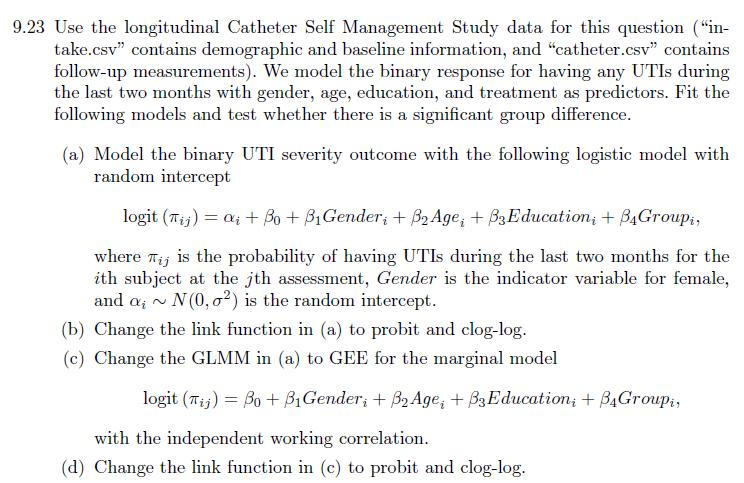In this question, we change the response in Problem9.23 to a three-level response by grouping the counts
Question:
In this question, we change the response in Problem9.23 to a three-level response by grouping the counts of UTIs into three levels, 0,1 , and \(\geq 2\). Fit the following models and test whether there is a significant group difference.
(a) Model the ordinal three-level UTI count outcome with the following cumulative model with random intercept
\[\operatorname{logit}\left(\gamma_{i j}\right)=\alpha_{i}+\beta_{0}+\beta_{1} \text { Gender }_{i}+\beta_{2} \text { Age }_{i}+\beta_{3} \text { Education }_{i}+\beta_{4} \text { Group }_{i},\]
\(j=1\) and 2 , where \(\gamma_{i 1}\) and \(\gamma_{i 2}\) are the probabilities of having no UTI and having at most one UTI, respectively, and \(\alpha_{i} \sim N\left(0, \sigma^{2}\right)\) is the random intercept.
(b) Change the link function in (a) to probit and cloglog.
(c) Change the GLMM in (a) to GEE for the marginal model
\[\operatorname{logit}\left(\gamma_{i j}\right)=\beta_{0}+\beta_{1} \text { Gender }_{i}+\beta_{2} \text { Age }_{i}+\beta_{3} \text { Education }_{i}+\beta_{4} \text { Group }_{i},\]\(j=1\) and 2 , with the independent working correlation.
(d) Change the link function in
(e) to probit and cloglog.
Problem 9.23 is:
Step by Step Answer:

Applied Categorical And Count Data Analysis
ISBN: 9780367568276
2nd Edition
Authors: Wan Tang, Hua He, Xin M. Tu





